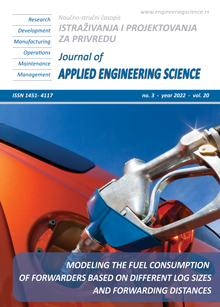THE CURRENT STATUS OF LEAN MANUFACTURING IN SMALL, MEDIUM AND LARGE SCALE MANUFACTURING COMPANIES OF KARACHI, PAKISTAN
Abstract
The major purpose of this study was to examine the current status of lean manufacturing in small, medium and large scale manufacturing companies situated in Karachi, Pakistan.The status of lean awareness, implementation, barriers and benefits in manufacturing companies were investigated through the questionnaire survey. The questionnaire was sent to 320 manufacturing companies and a response rate of 40.6% was received. SPSS 22.0 software was used to determine the average mean score for each factor and certain statistical analyses were performed to evaluate the results. It was observed that large organizations and SMEs both are fairly aware of the basic lean concepts but there is a sufficient difference in understanding of lean tools and techniques. Large organizations have a greater understanding and implementation of lean tools and techniques than SMEs. Some tools like 5S, Poka-yoke and TPM were found to have a similar status of implementation in various manufacturing companies irrespective of their size.The results of this study are applicable in Pakistani context, but could vary for other regions of the world, considering the awareness and challenges manufacturing enterprises are facing. To date there has been no research carried out in the context of large, small and medium manufacturing enterprises together in Pakistan, specifically in the Karachi region which investigate the status of lean awareness, implementation, benefits and barriers. Therefore, this study would serve as a foundation for conducting further in-depth studies on lean manufacturing in Pakistani manufacturing companies.
References
Kapuge, A.M. and M. Smith (2007): Management practices and performance reporting in the Sri Lankan apparel sector. Managerial Auditing Journal.
Dekier, Ł. (2012):The origins and evolution of Lean Management system. Journal of International Studies. 5(1): p. 46-51.
Alkhoraif, A., H. Rashid, and P. McLaughlin (2019): Lean implementation in small and medium enterprises: Literature review. Operations Research Perspectives. 6: p. 100089.
Cherrafi, A., et al. (2016): The integration of lean manufacturing, Six Sigma and sustainability: A literature review and future research directions for developing a specific model. Journal of Cleaner Production. 139: p. 828-846.
Kumar, P. and R. Kumar Singh (2021): Strategic framework for developing resilience in Agri-Food Supply Chains during COVID 19 pandemic. International Journal of Logistics Research and Applications: p. 1-24.
Cusumano, M.A., et al. ( 2021): Commentaries on “The Lenses of Lean”. Journal of Operations Management.
Chan, A.T.L., E.W.T. Ngai, and K.K.L. Moon (2017): The effects of strategic and manufacturing flexibilities and supply chain agility on firm performance in the fashion industry. European Journal of Operational Research. 259(2): p. 486-499.
Bhamu, J. and K.S. Sangwan (2014): Lean manufacturing: Literature review and research issues. International Journal of Operations & Production Management. 34: p. 876-940.
Das, S. and A. Patnaik, (2015): 4 - Production planning in the apparel industry, in Garment Manufacturing Technology, R. Nayak and R. Padhye, Editors, Woodhead Publishing. p. 81-108.
Holweg, M. (2007): The genealogy of lean production. Journal of operations management. 25(2): p. 420-437.
Rinehart, J., C. (2018): Huxley, and D. Robertson, Just another car factory?: Cornell University Press.
Melton, T. (2005): The benefits of lean manufacturing: what lean thinking has to offer the process industries. Chemical engineering research and design. 83(6): p. 662-673.
Costa, C., et al.( 2018): Implementation of 5S Methodology in a metalworking company. DAAAM International Scientific Book. 17: p. 001-012.
[14]- Kang, H.S., et al. (2016) Smart manufacturing: Past research, present findings, and future directions. International journal of precision engineering and manufacturing-green technology. 3(1): p. 111-128.
Cua, K.O., K.E. McKone, and R.G. Schroeder (2001): Relationships between implementation of TQM, JIT, and TPM and manufacturing performance. Journal of operations management. 19(6): p. 675-694.
Buer, S.-V., et al. (2021): The complementary effect of lean manufacturing and digitalisation on operational performance. International Journal of Production Research. 59(7): p. 1976-1992.
Vidor, G. and T.A. Saurin (2011): Concepts and features about poka-yoke systems: a literature review.
De la Vega-Rodríguez, M., et al. (2018): Lean manufacturing: a strategy for waste reduction. New Perspectives on Applied Industrial Tools and Techniques: p. 153-174.
Junior, M.L. and M. GodinhoFilho (2010): Variations of the kanban system: Literature review and classification. International Journal of Production Economics. 125(1): p. 13-21.
[20]- Grünberg, T. (2003) A review of improvement methods in manufacturing operations. Work Study. 52: p. 89-93.
Kumar, S., A.K. Dhingra, and B. Singh (2018): Process improvement through Lean-Kaizen using value stream map: a case study in India. The International Journal of Advanced Manufacturing Technology. 96(5-8): p. 2687-2698.
Gunasekaran, A., L. Forker, and B. Kobu (2000): Improving operations performance in a small company: a case study. International Journal of Operations & Production Management.
Shah, R. and P.T. Ward (2003): Lean manufacturing: context, practice bundles, and performance. Journal of operations management. 21(2): p. 129-149.
Shah, Z.A. and H. Hussain (2016): An investigation of lean manufacturing implementation in textile sector of Pakistan. in Proceedings of the 2016 International Conference on Industrial Engineering and Operations Management.
Purwanto, A., et al. (2020): Social and Management Research Quantitative Analysis for Medium Sample: Comparing of Lisrel, Tetrad, GSCA, Amos, SmartPLS, WarpPLS, and SPSS. JurnalIlmiahIlmuAdministrasiPublik: JurnalPemikiran Dan PenelitianAdministrasiPublik.
Mustaghis-ur-Rahman, R.R. and T. Jalees (2015): The effectiveness of support policies for SMEs in Pakistan: A study of Karachi based SMEs. Pakistan Business Review: p. 829.
Ankomah, E.N., J. Ayarkwa, and K. Agyekum (2020): The Need for Capacity Building of SMES for Lean Construction Adoption: A Literature Review.
Salem, R., et al. (2016): An empirical study on lean awareness and potential for lean implementations in Qatar industries. The International Journal of Advanced Manufacturing Technology. 82(9-12): p. 1607-1625.
Shetty, D., A. Ali, and R. Cummings (2010): Survey‐based spreadsheet model on lean implementation. International Journal of Lean Six Sigma.
uad, R.M., et al. (2021): Development and validation of a structured survey questionnaire on knowledge, attitude, preventive practice, and treatment-seeking behaviour regarding dengue among the resident population of Sabah, Malaysia: an exploratory factor analysis. BMC infectious diseases. 21(1): p. 1-11.
Amjad, A., I. Ramzan, and H.M. Hussain (2021): Lean Implementation in Pakistani Process Industries.

